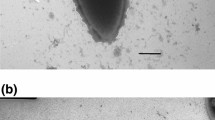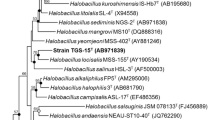Abstract
Two new mesophilic, sporeforming, gram-positive, strictly anaerobic, rod-shaped bacteria were isolated which utilized betaine in the Stickland reaction. Strain M1 was obtained from pasteurized hypersaline sediments. Cells were motile rods and formed spherical terminal spores. Betaine was used with hydrogen and several amino acids as electron donors. In addition, several carbohydrates served as substrates. Growth required 1.5% NaCl with an optimum at 6.0% NaCl. The guanine plus cytosine content of the DNA was 26.9%. This strain is described as a new species, Clostridium halophilum.
Strain W6 was isolated from marine sediments. Cells were motile rods and formed ovoid, subterminal spores. Betaine was used with hydrogen and several amino acids as electron donors. Carbohydrates were not fermented. Growth optimum was at 1.0% NaCl. The guanine plus cytosine content of the DNA was 26.1%. This strain is described as a new species, Clostridium litorale.
Similar content being viewed by others
Abbreviations
- DMG:
-
N,N-dimethylglycine
- TMA:
-
trimethylamine
- PY:
-
peptone-yeast extract
- PYG:
-
peptone-yeast extract-glucose
References
Andreesen JR, Zindel U, Dürre P (1985) Clostridium cylindrosporum (ex Barker and Beck 1942) nom. rev. Int J Bacteriol 35: 206–208
Bahl H, Andersch W, Braun K, Gottschalk G (1982) Effect of pH and butyrate concentration on production of acetone and butanol by Clostridium acetobutylicum grown in continuous culture. Eur J Appl Microbiol Biotechnol 14: 17–20
Beers JR (1967) The species distribution of some naturally occurring quaternary ammonium compounds. Comp Biochem Physiol 21: 11–21
Blunden G, Gordon SM, McLean WFH, Guiry MD (1982) The distribution and possible taxonomic significance of quaternary ammonium and other Dragendorff-positive compounds in some genera of marine algae. Bot Mar 25: 563–567
Bryant MP (1972) Commentary on the Hungate technique for culture of anaerobic bacteria. Am J Clin Nutr 25: 1324–1328
Cato EP, George WL, Finegold SM (1986) Genus Clostridium. In: Sneath PHA, Mair NS, Sharpe ME, Holt JG (eds) Bergey's manual of systematic bacteriology, vol II. Williams and Wilkins, Baltimore, pp 1141–1200
De Ley J (1970) Reexamination of the association between melting point, buoyant density, and chemical base composition of deoxyribonucleic acid. J Bacteriol 101: 738–754
Eneroth P, Lindstedt G (1965) Thin-layer chromatography of betaines and other compounds related to carnitine. Anal Biochem 10: 479–485
Finegold SM, Sutter VL, Mathisen GE (1983) Normal indigenous intestinal flora. In: Hentjes DJ (ed) Human intestinal microflora in health and disease. Academic Press, New York, pp 3–31
Freudenberg W, Andreesen JR (1989) Purification and partial characterization of the glycine decarboxylase multienzyme complex from Eubacterium acidaminophilum. J Bacteriol 171: 2209–2215
Gabbay-Azaria R, Tel-Or E, Schonfeld M (1988) Glycinebetaine as an osmoregulant and compatible solute in the marine cyanobacterium Spirulina subsalsa. Arch Biochem Biophys 264: 333–339
Galinski EA, Trüper HG (1982) Betaine, a compatible solute in the extremely halophilic phototrophic bacterium Ectothiorhodospira halochloris. FEMS Microbiol Lett 13: 357–360
Gerhardt P, Murray RGE, Costilow RN, Nester EW, Wood WA, Krieg NR, Phillips GB (1981) Manual of methods for general bacteriology. American Society of Microbiology, Washington, DC
Gillis M, De Ley J, De Cleene M (1970) The determination of molecular weight of bacterial genome DNA from renaturation rates. Eur J Biochem 12: 143–153
Holdeman LV, Cato EP, Moore WEC (1977) Anaerobe laboratory manual, 4th edn. Virginia Polytechnic Institute and State University, Blacksburg, Virginia
Hungate RE (1969) A roll tube method for cultivation of strict anaerobes. In: Norris JR, Ribbons DW (eds) Methods in microbiology, vol 3b. Academic Press, London New York, pp 117–132
Le Rudulier D, Bouillard L (1983) Glycine betaine, an osmotic effector in Klebsiella pneumoniae and other members of the Enterobacteriaceae. Appl Environ Microbiol 46: 152–159
Mackay MA, Norton RS, Borowitzka LJ (1984) Organic osmoregulatory solutes in cyanobacteria. J Gen Microbiol 130: 2177–2191
Mandel M, Marmur J (1968) Use of ultraviolet absorbance temperature profile for determining the guanine plus cytosine content of DNA. In: Grossmann L, Moldave K (eds) Methods of enzymology, vol XII B. Academic Press, New York, pp 195–206
Marmur J (1961) A procedure for the isolation of deoxyribonucleic acid from microorganisms. J Mol Biol 3: 208–218
Möller B, Hippe H, Gottschalk G (1986) Degradation of various amine compounds by mesophilic clostridia. Arch Microbiol 145: 85–90
Möller B, Oßmer R, Howard BH, Gottschalk G, Hippe H (1984) Sporomusa, a new genus of Gram-negative anaerobic bacteria including Sporomusa sphaeroides spec. nov. and Sporomusa ovata spec. nov. Arch Microbiol 139: 388–396
Mohammad FA, Reed RH, Stewart WD (1983) The halophilic cyanobacterium Synechocystis DUN 52 and its osmotic responses. FEMS Microbiol Lett 16: 287–290
Müller E, Fahlbusch K, Walther R, Gottschalk G (1981) Formation of N,N-dimethylglycine, acetic acid and butyric acid from betaine by Eubacterium limosum. Appl Environ Microbiol 42: 439–445
Naumann E, Hippe H, Gottschalk G (1983) Betaine: new oxidant in the Stickland reaction and methanogenesis from betaine and l-alanine by a Clostridium sporogenes-Methanosarcina barkeri coculture. Appl Environ Microbiol 45: 474–483
Pierce SK (1982) Invertebrate cell volume control mechanisms: a coordinated use of intracellular amino acids and inorganic ions as osmotic solute. Biol Bull 163: 405–419
Postgate JR (1963) Versatile medium for the enumeration of sulfate reducing bacteria. Appl Microbiol 11: 265–267
Schiefer-Ullrich H, Wagner R, Dürre P, Andreesen JR (1963) Comparative studies on physiology and taxonomy of obligately purinolytic clostridia. Arch Microbiol 138: 345–353
Smith LDS (1968) The clostridial flora from marine sediment from a productive and a non-productive area Can J Microbiol 14: 1301–1304
Stieb M, Schink B (1985) Anaerobic oxidation of fatty acids by Clostridium bryantii sp. nov., a sporeforming, obligately syntrophic bacterium. Arch Microbiol 140: 387–390
Storey R, Ahmad N, Wyn Jones RG (1977) Taxonomic and ecological aspects of the distribution of glycine betaine and related compounds in plants. Oecologia 27: 319–332
Yancey PH, Clark ME, Hand SC, Bowlus RD, Somero GN (1982) Living with water stress: evolution of osmolyte systems. Science 217: 1214–1222
Zindel U, Freudenberg W, Rieth M, Andreesen JR, Schnell J, Widdel F (1988) Eubacterium acidaminophilum sp. nov., a versatile amino acid-degrading anaerobe producing or utilizing H2 or formate. Arch Microbiol 150: 254–266
Author information
Authors and Affiliations
Rights and permissions
About this article
Cite this article
Fendrich, C., Hippe, H. & Gottschalk, G. Clostridium halophilium sp. nov. and C. litorale sp. nov., an obligate halophilic and a marine species degrading betaine in the Stickland reaction. Arch. Microbiol. 154, 127–132 (1990). https://doi.org/10.1007/BF00423321
Received:
Accepted:
Issue Date:
DOI: https://doi.org/10.1007/BF00423321




